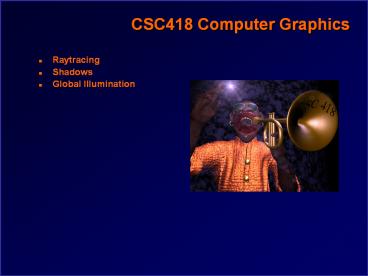CSC418 Computer Graphics - PowerPoint PPT Presentation
Title:
CSC418 Computer Graphics
Description:
Ray Tracing. Unifies in one framework. Hidden surface ... Intersection computation time is very long. Ray Tracing Efficiency Improvements. Bounding volumes ... – PowerPoint PPT presentation
Number of Views:27
Avg rating:3.0/5.0
Title: CSC418 Computer Graphics
1
CSC418 Computer Graphics
- Raytracing
- Shadows
- Global Illumination
2
Local vs. Global Illumination
- Local Illumination Models
- e.g. Phong
- Model source from a light reflected once off a
surface towards the eye - Indirect light is included with an ad hoc
ambient term which is normally constant across
the scene - Global Illumination Models
- e.g. ray tracing or radiosity (both are
incomplete) - Try to measure light propagation in the scene
- Model interaction between objects and other
objects and objects and their environment
3
All surfaces are not created equal
- Specular surfaces
- e.g. mirrors, glass balls
- An idealized model provides perfect reflection
- Incident ray is reflected back as a ray in a
single direction - No scattering (unrealistic)
- Diffuse surfaces
- e.g. flat paint, chalk
- Lambertian surfaces
- Incident light is scattered in all directions
- Also unrealistic for most surfaces
4
Categories of light transport
- Specular-Specular
- Specular-Diffuse
- Diffuse-Diffuse
- Diffuse-Specular
5
Ray Tracing
- Traces path of specularly reflected or
transmitted (refracted) rays through environment - Rays are infinitely thin
- Dont disperse
- Signature shiny objects exhibiting sharp,
multiple reflections - Transport E - S S S D L.
6
Ray Tracing
- Unifies in one framework
- Hidden surface removal
- Shadow computation
- Reflection of light
- Refraction of light
- Global specular interaction
7
Raytracing slides borrowed from
8
9
Ray tracing setup
10
11
Ray does not intersect objects
12
13
14
15
Ray hits object
16
17
Shadow test
18
19
Point in shadow
- With a simple lighting model, apply the ambient
term for the shadow region
20
21
22
Reflected ray is sent out from intersection point
23
Reflected ray has hit object
- Local illumination model calculated where ray
intersects with second object - Result carried back to origin of ray on first
object, contributes to objects colour
24
25
Transmitted ray generated for transparent objects
26
Transmitted ray hit object
- Local illumination model calculated where the ray
hit object - Result carried back to the point of first
intersection
27
28
No reflection
29
Single reflection
30
Double reflection
31
Ray Tracing Deficiencies
- Local specular illumination model spreads rays in
specular reflection, but global model doesnt - Ignores major light transport mechanisms
- Interaction of diffuse surfaces
- Intersection computation time is very long
32
Ray Tracing Efficiency Improvements
- Bounding volumes
- Spatial subdivision
- Octrees
- SEADS
- BSP
33
Ray Tracing Improvements Image Quality
- Backwards ray tracing
- Trace from the light to the surfaces and then
from the eye to the surfaces - shower scene with light and then collect it
- Where does light go? vs Where does light come
from? - Good for caustics
- Transport E S S S - D S S S - L
34
Ray Tracing Improvements Image Quality
- Cone tracing
- Models some dispersion effects
- Distributed Ray Tracing
- Super sample each ray
- Blurred reflections, refractions
- Soft shadows
- Depth of field
- Motion blur
35
Radiosity
- Diffuse interaction within a closed environment
- Theoretically sound
- View independent
- No specular interactions
- Transport E D D D - L
36
Direct light is only part of the story
37
Ambient light
38
Lambertian Reflection and Colour Bleeding
39































